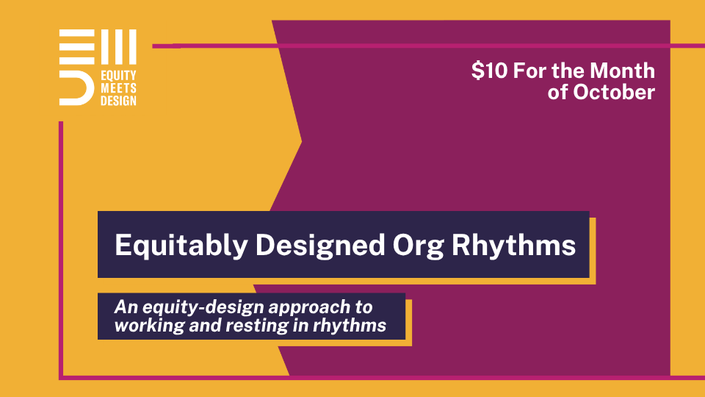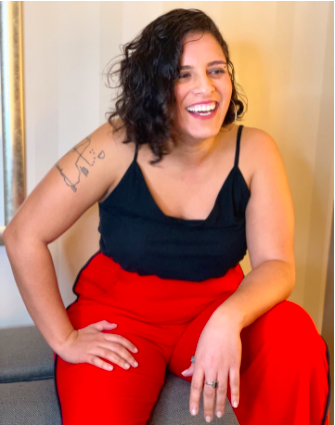
Equitably Designed Org Rhythms (Tiny Course)
What this tiny course is about:
We’ve been working on equitably designing extended, simultaneous paid time off for our team/org for many years, leading us to also create off-ramps and on-ramps to make the transitions between work/break times more graceful, reflection practices and learning loops to make both rest and work times more powerful, and structures that have made it possible for us to spend less time being “open” while still fulfilling work commitments with quality and integrity (thereby enabling and, very importantly – sustaining – our longer break times).
Over the course of this time, we’ve tried lots of things, learned a lot, failed some, and finally have equitable and effective designs around many aspects of org rhythms that are currently working quite beautifully for our team, and we’d love to share what we’ve learned (so far!).
What the Tiny Course Contains:
This course contains two recordings. The first is a 2-hour workshop recording with 90 minutes of content and 30 minutes of Q&R. The second video is another hour of Q&R that we didn't get to during the 2-hour workshop. (Q&R stands for “Questions & Responses, a perhaps slightly more existentially humble version of “Questions & Answers” 😉). We also link to sample documents and additional resources we mention in our responses.
The Backstory:
If you haven’t heard [despite our very best efforts to relentlessly and shamelessly brag about it], we take six weeks off in the summer and four weeks off in the winter, and these breaks happen at the same times every year for everyone on the team. Yep, you read that correctly: Equity Meets Design – a for-profit business – straight up closes for 10 weeks every year, and paychecks continue to get cut while the phones stay ringing 💁🏽♀️ (jk we totally tell our clients about this, even before they become clients…that’s usually when they ask to become employees 🤣).
We have collectively learned to use those times off for the purpose of actually resting, and, in finally mastering that, we realized that our org closures not only make us rest better, they also make us work better (and not just because we’re rested 😏).
Here’s what we mean:
Given that we’re working on problems we don’t expect to ever fully solve, problems so complex their layers are infinite, in a field where we can always do more and do it better – it’s not only easy but also genuinely tempting to get sucked into a feeling of deficient perpetuity, an existential blackhole of never-ending and incomplete effort, an anti-hedonic treadmill that continually reminds us that what we’re doing is not enough and never could be.
At EMD, we put a stop to the spiritually hollow inertia of productivity culture and instead choose to revel in this sense of impossibility rather than drown in it, resisting the seductive and yet self-destructive lies that 1. Everything is achievable, and hence, 2. Everything is important. We’ve created endings and beginnings where there were none, relinquished the fantasy of Saving the Day™ by only committing to the parts of this work that are truly ours to do, and scoped our work in seasons, forging meaning and finding focus (and even freedom) in our constraints.
And this is how we got there:
- We committed as an organization to opening and closing at certain times, which forced us to think about how we actually open and close, building bridges and transitions in order to more gracefully on-ramp and off-ramp.
- Our off-times impacted the design of our on-times – since we’d already surrendered to that fact that we wouldn’t be working on everything…everywhere…all at once (*multidimensional hat tip to Dan Kwan*), we had to get super intentional about exactly what work we chose to do each semester, why, and how.
- These “seasons” (or “semesters” as we affectionately – and perhaps slightly masochistically 😉 – call them) lent themselves to natural and habitual reflection times about what worked and what didn’t both inside and outside of our breaks, in turn pushing us to define how we could systemize and/or improve things for next time. Full disclosure: we can’t take total credit for knowing in advance that we needed these reflection times, but opening and closing made it easier to schedule them, and more obvious that they were missing when we didn’t do them. That’s important to note, because they’ve been absolutely crucial in helping us to iteratively design increasingly restful off-times and ever-more-potent on-times.
So, for us, endings and beginnings force us to continually grapple with limitations in our capacity, time, and energy. Paradoxically, it is only through this cycle of seeing and accepting our limitations that we’ve been able to use the precision of our intention to propagate our learnings each step of the way.
This is a meditation on humility that asks us to constantly devastate our egos and the false conditioning that says that there is always more work to be done and that doing it well requires us to commit self-sacrificially to an unchanging course of action – that exhaustion and blind steadfastness are somehow emblematic of our devotion to solving the thing we say is unacceptable about the way the world works. Nah, that ain’t it sis – there’s a better way, one we fondly refer to as “process as product.”
To that end, we’re a living, breathing, actively evolving learning organization – we pay as much attention to how we do things as we do to actually doing said things. The catch is that this is made possible only by a deep, ever-present, and never-not-uncomfortable acknowledgement that things don’t usually or even frequently end up unfolding how we’d expect, and that *almost all of the time* things take longer than we’d like (a painful reality that’s a lot easier to ignore when you indulge the [albeit costly and dehumanizing] illusion of bottomless capacity, time, and energy).
Given that, we want to be upfront that deciding to close for extended and regular periods won’t automatically mean that it will happen smoothly or that you’ll learn from every iteration. Opening and closing, opening and closing in a non-jarring way, and opening and closing while making time for reflections, learnings, and iterations are disparate but parallel processes that require different but related intentions – namely that we slow down long enough to question The Way Things Have Just Always Been Done™, consider possibilities for doing things in new ways, and build both individuals’ and the organization’s capacity for uncertainty and mutation.
Learning to see with clear eyes and move with a sober heart is always a good thing, but especially important when the matter at hand is as foundational and worthwhile as the work of equity, justice, liberation, and belonging. And, in a strange and yet sort of fated way, surrender often precedes transcendence – it’s been our experience that grounding down is exactly what we need in order to ascend.
Your Instructor

Dr. Christine Ortiz Guzman is a serial entrepreneur with a passion for innovation through equity-centered design. Her current venture is Equity Meets Design, a think & do tank that builds capacity in folks to use an equity-centered design process to answer the question "How do I do equity?" Their equity by design process supports individuals and organizations to intentionally design their interventions, interactions and institutions for equity and justice.
Christine spent her teenage years creating the national Truth tobacco prevention campaign and launched her first consulting firm at 17, supporting states and other countries interested in implementing the Truth model. She has launched k-12 microschools, consulted for schools in the US and internationally, designed and coached entrepreneurs, coordinated a national competition for innovative school models, and designed and taught graduate-level courses on redesigning schools at the Stanford d.School and Harvard University.
The first in her family to have a college degree, Christine has a BS from MIT, Masters in Education and Non-Profit Management, and a Doctorate in Education Leadership from Harvard University. In all her endeavors, she has been motivated to address the barriers innovators face when tackling complex equity-based social issues, leveraging and accounting for the entirety of who she is, especially her experience being a Latina and a mother from the south. She lives in Orlando, Florida with her teenage and toddler daughters.
